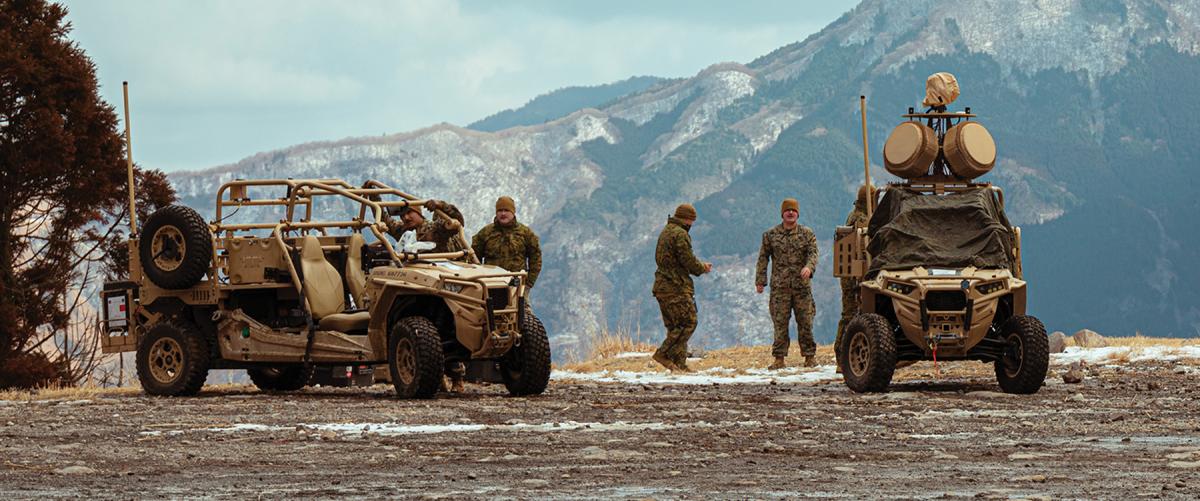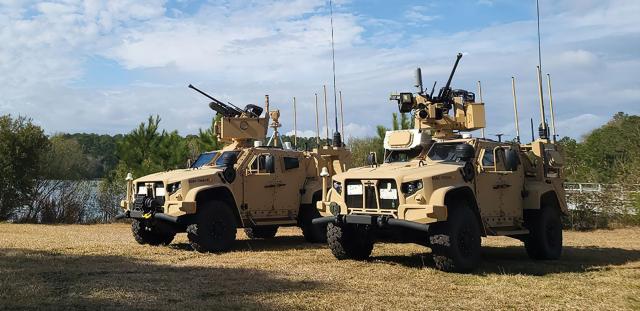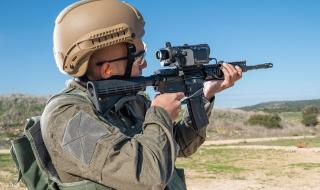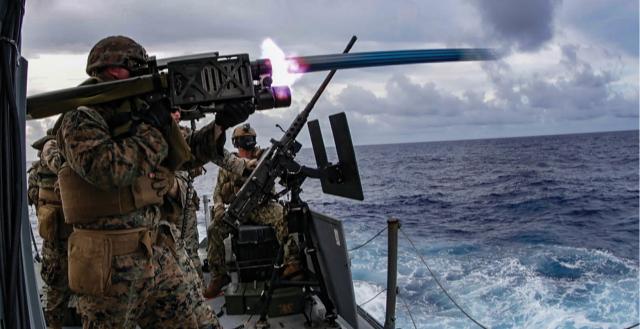A significant cultural shift during the early years of the global war on terror led to the development and adoption of capabilities and tactics to counter improvised explosive devices (IEDs). Today, unmanned aerial systems (UASs) pose a threat similar to that of IEDs. The Marine Corps must develop counter-UAS (C-UAS) tools to improve battlefield survivability servicewide, but especially for stand-in forces, which will be expected to operate outside the envelope of other air-defense assets. They will be vulnerable to all aerial threats, UASs in particular, because most of the Marine Corps’ antiair weapons are not designed to defeat the UAS threat. The response cannot be limited to specialized units with unique capabilities. Rather, the entire Marine Corps must focus on C-UAS.
The counterinsurgencies U.S. forces waged in Iraq and Afghanistan were informed by the insurgents’ employment of asymmetric capabilities, most notably IEDs. The United States and its partners developed a wide range of high-tech, complicated, and often expensive systems to counter them: mine-resistant ambush-protected vehicles (MRAPs), cellphone jammers, and buried-mine detectors, to name just a few. The systems generally worked, often well, but they could never entirely defeat the IED threat. Insurgents adapted to MRAPs by employing larger and more numerous IEDs. And, when infantrymen dismounted, they still bore the burden of patrolling through IED-laden terrain. The complexity and expense of the U.S. response made it harder to match those adaptations.
Tactics and training also played a role. Vee sweeps cleared roads, with infantry and vehicles providing mutual support, while trained soldiers and Marines searched for IED indicators. Small units practiced setting cordons around suspected devices to allow explosive ordnance disposal (EOD) personnel to render them safe. U.S. forces also quickly recognized the importance of being “left of bang”—disrupting the enemy’s IED kill chain as early as possible.1
More recently, the 2020 Nagorno-Karabakh war and the ongoing Russia-Ukraine war have demonstrated the effectiveness of UASs. In those conflicts, unmanned systems have been used at a scale and sophistication far beyond those of any previous conventional war. UASs and loitering munitions (LMs) proved crucial to Azerbaijan’s victory. Ukraine’s Turkish-built Bayraktar drones grabbed headlines early in the 2022 invasion when they destroyed Russian vehicles with precision munitions.2 Russian Lancet-3 LMs have likewise been documented destroying high-value Ukrainian targets such as surface-to-air missile systems and howitzers.3
In addition to purpose-built systems, Ukrainian volunteer groups have used commercially purchased and custom-built unmanned aerial vehicles (UAVs) armed with obsolescent Soviet antitank hand grenades to great effect. One of these drones costs around $20,000 and boasts a four-kilometer range.4 This is comparable to the range of an antitank missile, but the drone is much cheaper—and, unlike a missile, it has the advantage of being reusable.
The threat, in other words, is considerable.
Death from Above
The vulnerability of modern ground forces to UAVs should alarm the Marine Corps. John Antal’s book Seven Seconds to Die provides an in-depth analysis of the 2020 Nagorno-Karabakh war with a focus on UASs. It describes Azerbaijan initially targeting Armenian air-defense and electronic warfare systems, then shifting priorities to other critical targets. In the first 15 minutes of the war, drones destroyed half of Armenia’s antiaircraft forces and 40 percent of its artillery. Azerbaijani strikes were unrelenting: for weeks, Bayraktars and Israeli-built Harop and Orbiter LMs systematically destroyed air defenses even when the defenses were active. Azerbaijani UAVs could then fly unimpeded and strike other forces at will, combining sensors with precision fires to hunt Armenian forces with impunity. All told, Azerbaijani UASs destroyed at least 1,000 Armenian military systems during the six-week war.5 For the Marine Corps, this would equate to the destruction of every planned amphibious combat vehicle, nearly twice over.
On its final page, Seven Seconds to Die poses three questions:
Would NATO combat units fare any better than the Armenians under a similar, unmanned whirlwind? Has NATO fielded the integrated air defense capability to counter [UAS] and LM assaults? How many NATO units have recently trained against [UAS] and LM swarm attacks?6
For the Marine Corps, the answers are that it would fare poorly: The service lacks appropriate air-defense systems and does not train for an enemy with a robust UAS capability. Existing tools are few and far between: Stinger missiles and the Marine Air Defense Integrated System (MADIS), which are exclusive to air-defense battalions at present.7 While standing up more of these units is a step in the right direction, it is insufficient. Infantry, artillery, assault amphibian, and light armored reconnaissance ground combat units will continue to lack organic antiair systems with which to defend themselves.
Were the ground units to receive existing air-defense tools, they would still be vulnerable. The Stinger-missile-equipped MADIS Mk 1 (mounted on a Joint Light Tactical Vehicle [JLTV]) is designed primarily to defeat conventional aircraft.8 It does so by sensing the infrared and ultraviolet signatures of aircraft turbine exhaust, but the missile’s seeker is not tuned to acquire the comparatively small signature of many UAVs.
While Armenia mostly fields Soviet-built air-defense systems, modern air defenses also have been destroyed by UASs.9 A simple yet effective tactic is to overwhelm surface-to-air missile (SAM) launchers with sheer numbers. One video, allegedly recorded by an Israeli LM, even shows a state-of-the-art Russian-built Pantsir air-defense vehicle—which integrates search and fire-control radars, thermal imaging sensors, SAMs, and 30-mm autocannons—firing multiple missiles at incoming UAVs to no avail.10
The JLTV-mounted MADIS Mk 2’s electronic warfare system is designed for C-UAS, and the Polaris MRZR–mounted L-MADIS has proven an ability to destroy UAVs, but neither has been tested in the same high-level threat environment as the Nagorno-Karabakh or Russia-Ukraine wars. Furthermore, even if they prove to be more effective than systems such as Pantsir, the number of air-defense battalions (even after the planned increase) will simply be too few to provide coverage across the Marine Corps. The L-MADIS is a step (possibly several steps) in the right direction—but insufficient in number and testing for now.
Fight Like You Train
C-UAS training is also behind the curve. While air-defense Marines are experts in their trade, the sophisticated training does not extend beyond this small community. The most recent Infantry Training and Readiness Manual has four counter-IED individual-level tasks, but no tasks specific to air defense. The latter is mentioned only briefly, as a subcomponent of two force-protection tasks at the platoon and squad levels.11 Light armored reconnaissance and artillery training and readiness manuals also mention air defense only briefly, as subcomponents of security tasks.12 The assault amphibian training manual does not mention air defense at all.13 To survive on today’s battlefield, not only will battalion- and company-sized elements need to train specifically for C-UAS, but individual Marines will need to do so, too.
Given the dangers posed by UASs and their widespread proliferation, the Marine Corps must adapt quickly. In the short term, the Marine Corps should acquire more of the C-UAS systems already in service, explore newer and more capable C-UAS systems, and train all Marines to at least a base level of C-UAS capability. The Marine Corps already operates the MADIS Mks 1 and 2 and the L-MADIS. In the short term, it would be wise to procure more of each, especially the latter.
The Marine Corps also should fundamentally rethink how it fields air-defense systems. In recent decades, U.S. ground forces have operated largely without concern about enemy aerial threats. Other countries—notably Russia and its Soviet precursor—have always had to concern themselves with such threats and have incorporated antiair systems with armor and infantry formations for decades, even down to the platoon level. The Marine Corps’ antiair battalions and Stinger missiles provide an adequate defense against manned planes and helicopters. The Marine Corps should consider fielding C-UAS systems similarly: organic to ground combat units, as well as specialized battalions. Concurrently, it should evaluate how emerging technologies such as high-powered microwave and man-portable C-UAS systems can be used at lower echelons.14
The Tools
None of the MADIS systems are presently mounted on amphibious vehicles, meaning the first stages of amphibious assaults will lack organic air defense. The Marine Corps should consider a C-UAS variant of the Amphibious Combat Vehicle (ACV) using the MADIS suite or even developing an entirely new system. The Army is currently evaluating a laser-armed short-range air-defense variant of the Stryker. It is intended for C-UAS but also is undergoing testing to destroy rockets, artillery, and mortar rounds, and it might be adaptable for Marine Corps purposes.15 There is precedent for such interservice cross-pollination: The updated TOW system from the Army’s M1134 antitank variant of the Stryker was adapted for use by light armored vehicles and remains in Marine Corps service.
Another intriguing possibility is a system that could turn every Marine into a ground-based C-UAS asset. The Israeli company Smartshooter has developed rifle-mounted optics that can track UAVs, continuously compute a firing solution, and enable the user to fire only when the rifle is aimed to hit the target. One company video shows a rifleman destroying a quadrotor with a single shot.16 These optics offer other advantages, too. Though heavier than the rifle combat optical currently in service, the four-power magnification Smartshooter incorporates a low-light mode and laser rangefinder and is compatible with 7.62-mm and 5.56-mm rifles.17 As of October 2022, the Marine Corps was evaluating these optics. Procuring and distributing them to all units would give individual Marines their own active defense against drones.
The Marine Corps also should explore passive C-UAS measures. Another lesson from recent wars is the use of specialized armor. In November 2022, it was reported that a Ukrainian self-propelled howitzer was hit by a Russian UAS but survived because it was protected by “hedgehog armor” on its roof. This nonexplosive reactive armor consists of rubber mats with cylindrical studs designed to detonate shaped charges—commonly used by UAVs and other top-attack weapons—farther from the vehicle, reducing their effectiveness. Photographic evidence suggests that the armor reduced damage to the howitzer.18 This sort of defense could be mounted on most existing vehicles in the short term, rather than waiting for the fielding of specialized armored vehicles like MRAPs.
Stop Them Before They Start
Adopting ground-based air-defense measures will certainly be beneficial, but, as with IEDs, an even better threat mitigation would be to disrupt the adversary’s kill chain early. One system that could achieve this is MORFIUS, a Lockheed Martin–built UAS designed to disable or destroy enemy UASs with high-powered microwave emitters. The company says the benefit of such a system is its ability to fly to a threat and “extend [its] capabilities to significantly farther ranges,” while ground-based systems have comparatively shorter ranges.19 This is conceptually much the same as disrupting IED emplacement with aggressive dismounted patrols: MORFIUS-like systems could interdict enemy UAVs before they could locate friendly ground forces.
Because UAVs do not follow a ballistic trajectory, it can be difficult for counterbattery radars to determine a point of origin. Though the specifics of its sensing capabilities are classified, it is possible MORFIUS could help determine the point of origin of enemy UAVs. This would expedite targeting of enemy drone launchers and operators.
Beyond equipment, the Marine Corps must revamp its C-UAS training as well. During the war on terror, Marines of all specialties were trained for counter-IED, though not to the proficiency of EOD personnel. Marines today must be similarly trained on C-UAS tactics and techniques. Every individual Marine need not be expected to have the same level of proficiency as air-defense specialists. Rather, entry-level training for all Marines should incorporate basic C-UAS considerations such as becoming familiarized with UAS capabilities, employing overhead cover and concealment, serving as an air sentry, and reacting to attack.
Adapt and Improvise
In the fleet, small unit leaders should seek opportunities to reinforce C-UAS proficiency and refine the skills of their Marines. Thanks to the earlier counter-IED culture shift, Marines became instinctively cognizant of the IED threat. Today, Marines must be similarly ingrained with a C-UAS mindset. They also should be encouraged to experiment with simple, off-the-shelf equipment to reduce their signatures or mitigate UAS threats in other ways. Young soldiers and Marines faced with the reality of IEDs improvised with whatever they could get their hands on—including silly string and remote-controlled toys—to save lives.20 Such ingenuity may lead to similar solutions for C-UAS today.
Conflicts in recent years have shown that UASs are effective against modern militaries because they integrate observation and precision-strike capabilities. Marines must adapt to mitigate this deadly threat, and the Marine Corps needs to field more C-UAS equipment and improve training. The Armenian military was not ready for a UAS onslaught. The Marine Corps must act quickly to ensure it is, or it risks a similar fate.
1. Patrick Van Horne and Jason Riley, Left of Bang: How the Marine Corps’ Combat Hunter Program Can Save Your Life (New York: Black Irish Entertainment, 2014), 15–17.
2. “Defending Ukraine—Listing Russian Military Equipment Destroyed by Bayraktar TB2s,” Oryxspioenkop.com, 25 March 2022.
3. “ZALA Lancet,” Military Today, www.military-today.com/aircraft/lancet.htm.
4. Alia Shoaib, “Inside the Elite Ukrainian Drone Unit Founded by Volunteer IT Experts: ‘We Are All Soldiers Now,’” Business Insider, 9 April 2022.
5. John Antal, Seven Seconds to Die: An Analysis of the 2020 Nagorno-Karabakh War (Havertown, PA: Casemate Publishers, 2022), 22, 79, and 121.
6. Antal, Seven Seconds to Die, 146.
7. Isaac Liston, “U.S. Marines Activate New Littoral Anti-Air Battalion,” Marine Corps News, 14 February 2022.
8. “Marine Air Defense Integrated System (MADIS),” Missile Defense Advocacy Alliance, 8 July 2020.
9. Altan Ozler, “Libya: A Catastrophe for Russian’s Pantsir S1 Air Defense System,” RealClearDefense.com, 29 June 2020.
10. “Pantsir S-1,” Center for Strategic and International Studies Missile Defense Project, 6 July 2021; and “Israeli Air Force Destroyed Another 2 Pantsir SAMs in Damascus, 21.01.2019.”
11. U.S. Marine Corps, Infantry Training and Readiness Manual (Washington, DC: Headquarters U.S. Marine Corps, 7 May 2020).
12. U.S. Marine Corps, Light Armored Reconnaissance Training and Readiness Manual (Washington, DC: Headquarters U.S. Marine Corps, 14 March 2017); and Artillery Training and Readiness Manual (Washington, DC: Headquarters U.S. Marine Corps, 29 October 2018).
13. U.S. Marine Corps, Assault Amphibian Training and Readiness Manual, (Washington, DC: Headquarters U.S. Marine Corps, 7 July 2021).
14. “Leonidas High-Power Microwave (HPM) System,” Army Technology, 5 April 2023; and Eyal Boguslavsky, “MCTECH Presents New Manpack System Enabling Troops to Detect, Neutralize Drones,” Israel Defense, 5 September 2021.
15. Andrew Eversden, “‘Bullet Made Out of Light:’ Army to Field First Stryker-Mounted Combat Laser in Next 45 Days,” Breaking Defense, 10 August 2022.
16. Smartshooter, “C-UAS Elimination, the Netherlands 2020,” 22 March 2021.
17. “SMASH X4 Magnifying Fire Control System for Small Arms,” Smartshooter.
18. Sebastien Roblin, “Hedgehog Armor Saves Ukraine’s German Built Super Howitzer from Russian Kamikaze Drone,” Forbes, 29 November 2022.
19. “Counter-Swarm Technology Combats Threats,” Lockheed Martin Corporation, 30 March 2021.
20. Miguel Ortiz, “4 Everyday Items with Surprising Military Uses,” Business Insider, 9 December 2020; and Scott Stump, “He Saved Six Soldiers’ Lives—With a Child’s Toy,” Today, NBC Universal, 9 August 2011.






